Piste skiing in Val Gardena
Val Gardena is one of the busiest skiing valleys in the Dolomites and for good reason, with a system which is well organised, extensive to say the least, amazing views, some awesome skiing and a network of huts and restaurants which offer superb food and good value.
It links easily into Alta Badia, Val di Fassa and Alpe di Suisi with a network of lifts, buses and tram links. The villages are beautiful and traditional south Tyrolean villages which offer all mod cons. If there can be any criticism, it would be that it has become a victim of its own success and for my own tastes has become overdeveloped and lost a little of its heart in doing so.
Back to the skiing. The valley can be roughly divided into five distinct areas:
- Passo Sella and Plan de Gralba
- Ciampinoi and Selva di Gardena
- Monte Pana
- Seceda
- Dantercepies andPasso Gardena
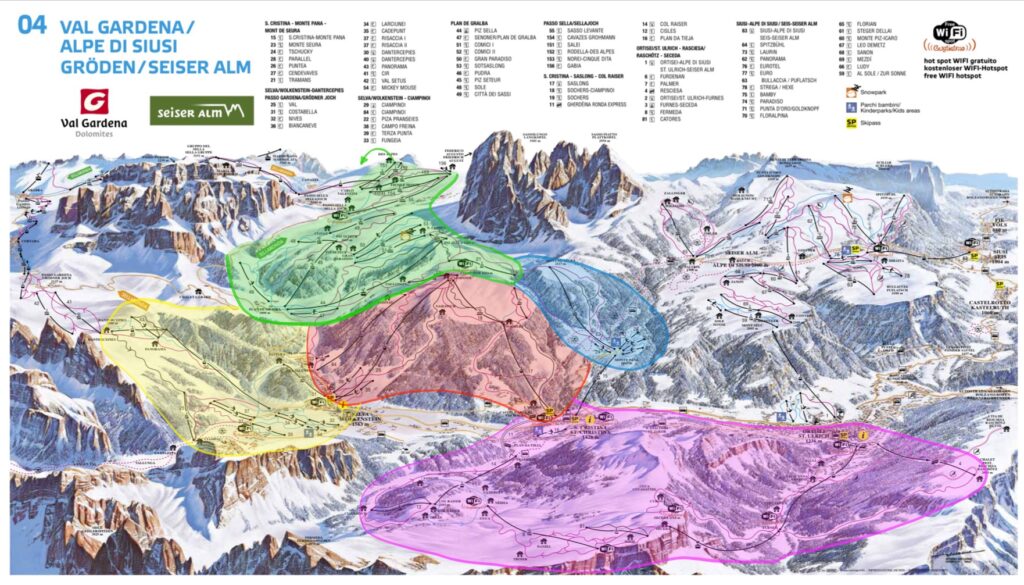
Accessing the valley from other areas
The valley is easily accessed from Val di Fassa:
- use the Campitello gondola to reach the Sella Pass and ski down into the valley.
- drive to Lupo Bianco on the way to the Sella Pass and access the pass using the bubble lift ascending the left side of the valley.
- Drive over Sella Pass to reach any of the valley resorts or Plan de Gralba – in my view this is not a great option as it’s quite a long drive, especially if you are not used to snowy driving conditions.
From Alta Badia
- Take the lift system to Passo Gardena from Colfosco or Corvara described here.
- Drive over the pass; this is sometimes not possible, especially after snow as the slopes descending from Passo Gardena become avalanche prone and the road is closed.
From Alpe di Siusi
- Take the lift system to reach the Ortisei to Alpe di Suisi bubble lift. You then walk a short distance across town to reache the Seceda ski area.
- Ski to Saltria where you can use the Snow Bus (this is a road inaccessible by any other transport) and which allows you access to Monte Pana and from there Ciampinoi and Plan di Gralba.
- Drive from Castelrotto into the valley. This is quite quick and easy as the road is usually snow free.
Plan de Gralba and Sella Pass
This is one of my favourite areas in the Dolomites; there is a mix of mainly easy and intermediate runs in utterly breathtaking scenery, well served by huts and lifts and I have been to some resorts which offer in their entirety as much as this one sector alone, especially when you consider that the Selva Gardena/Ciampinoi and Monte Pana areas are completely linked to this area.
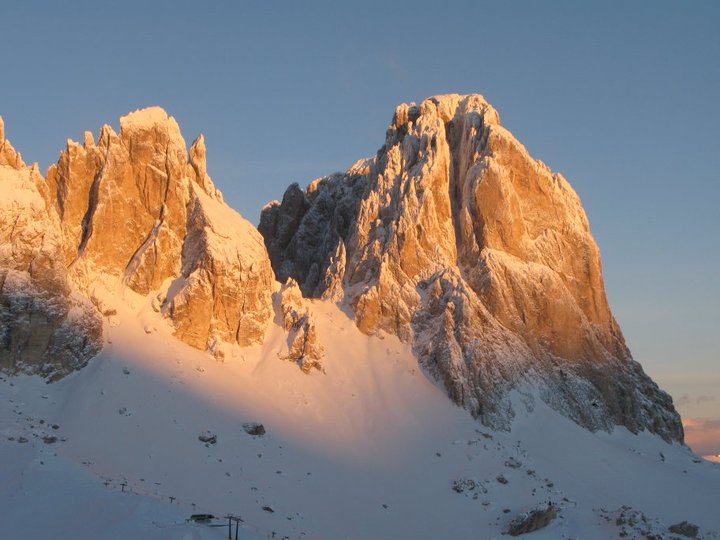
The area stretches from Passo Sella in the south to the summit of Ciampinoi, with two areas of piste with linking runs inbetween them. The southern area is centred on the Sella Pass, and from here you can ski (providing you have the right pass) in both the Val Gardena and Val di Fassa areas. The views are absolutely to die for, in my many years of travelling in mountainous areas, this is absolutely my no. 1 spot and it never disappoints me.
There is a large area of easily navigated red runs here, from the top of Col Rodella and it’s great fun to take laps here. There are also some excellent huts – Rifugio des Alpes has a party bar with incredible views of Sass Pordoi and Civazes. Meanwhile Rifugio Friedrich August has great food and panoramic windows towards the Cantenaccio.
All the runs here are quite mellow with the slight exception of #3 Tre which has a bit of an “end of the earth” feeling to start which coupled with the impressive surroundings can leave less able skiers a little spooked.
There is also a boardercross which is great fun for racing your friends on! Overall you could easily spend half a day taking laps in this area, especially if you drop down to Lupo Bianco which is a great run.
When you’ve thoroughly explored this area, there is a long and very easy blue Sas Betit. This starts on the Val Gardena side of the pass, at the back of the large Hotel Passo Sella. Make sure you keep up as much speed as possible for the first section as it is quite flat – it’s a bit of a nightmare for boarders as it’s easy to catch an edge and end up doing a long walk of shame! However, if you are peckish, I can recommend the Malga Sella which offers very tasty traditional fare in stunning surroundings.
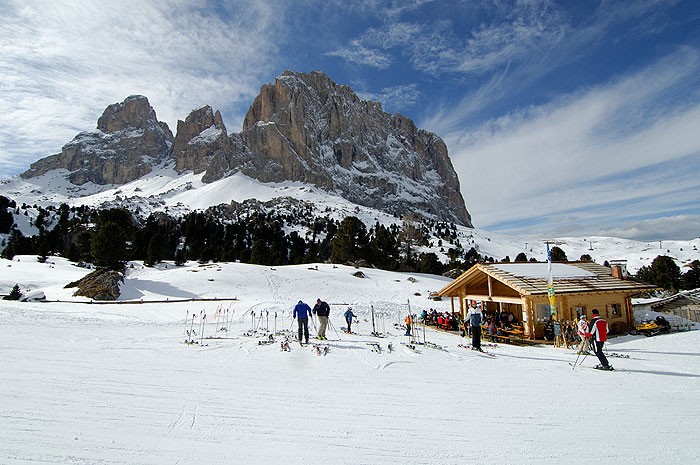
You soon reach the start of Plan de Gralba where you can either continue down the easy blue to the main lift area, or you can take a lift on your left to Piz Seteur for some more taxing descents, or to access the large bowl directly beneath Sassolungo. Falk descends to Plan de Gralba from the top of this lift and is an extremely pleasant red run which twists and winds down through the tree. Or take the Citta dei Sassi lift (skiers right as you descend back beneath the lift) and this gains access of either a nice red back to Piz Seteur or a blue which takes you into the bowl.
Let me take a moment now to talk about this bowl. There are numerous runs, all very moderate and this is an ideal area for beginners. But also it is extremely fun, because it has been made into somewhat of a funpark, with a great number of specialised runs, a boarder cross, a snow park, timed runs. Its fantastic for families who will delight in all these kid friendly facilities and you’ll be able to spend plenty of hours here! Indeed I have had guests who were so enamoured with it, they went back 2 days running! As well as these easier runs, by including taking the lift to Piz Sella by the Comici chairlift, you can take in some good reds and a black. The Rifugio Comici in this area is excellent place to have lunch too with excellent food in the shadow of Sassolungos North face, an imposing 1000m high wall of rock.
It’s also worth mentioning that Piz Sella, which can also be reached directly by gondola from Plan de Gralba is the starting point to reach the Monte Pana area, via the Tramans red run. In my opinion the best way to reach this is by skiing the southern slopes of Piz Sella down to Rifugio Comici and then turn right – you can reach it by a steep, narrow and frequently icy black to the north called Piz Sella 5, but it’s not an easy black nor very pleasant, with people often feeling intimidated by its position and steepness.
Tramans is really worth seeking out, as it takes you beneath Sassolungo, which as you turn the corner becomes steeper and taller. Owing to it’s out of the way situation, it’s not usually busy and it feels isolated and remote. It also serves as a way of reaching Ciampinoi whilst avoiding the steep section of the Piz Sella 5 black run as the lift from the end of the run takes you to the less aggressive lower section of of Piz Sella 5 and this means you can either ski all the way to Plan de Grabla or to get the lift called Piza Panseies both of which lead to the Ciampanoi/Selva Gardena areas.
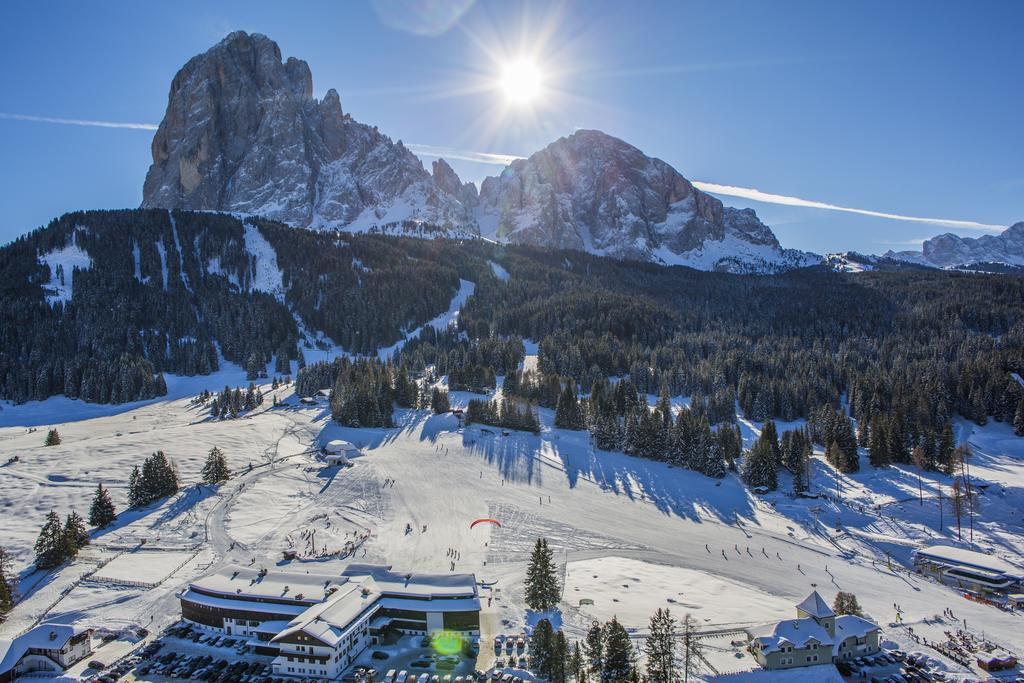
Monte Pana
Monte Pana is a small area nestled beneath the Salame del Sassolungo and has a large school area and several really worthwhile runs. Because it’s difficult to access and out of the way, the longer runs are quiet and their position ensures great views.
It also is one of the stops for a unique snow bus which you can take to the back end of Alpe di Suisi, which drives up a snow covered road to Saltria. To reach the area, either take a lift up from Santa Christina, drive up or ski from Piz Sella as described in the previous section.
If arriving from Tramens, rather than taking the lift at the end of the run continue down the very easy blue, Charly to the Mont de Seura lift. This lift provides amazing views of Sassolungo and Alpe di Siusi and two great runs, Alpha and Bravo, a black and a red. Both are worth the trip over, especially to get away from the crowds and because the red Bravo is used as a reserve slope for womens Giant Slalom races. Once you’re done you can return to Plan de Grabla by descending the Charly piste back to the two man chair.
Ciampinoi and Selva Gardena
This final area on the southern side of Val Gardena is another stonker! It’s home to the FIS downhill, the Saslong. But also many other great runs, mainly long and a bit harder than in the adjoining Plan de Gralba/Sella pass area. Centred around the Ciampinoi summit, it is quite a straight forward area to understand. Most of the runs descend the Northern side of the mountain towards Selva and Santa Christina, whilst two link back to Plan de Gralba.
I’ll quickly talk about these two runs so that we can then concentrate on the others.
The return to Plan de Gralba
There are two ways to get back to Plan de Gralba, both are red runs and both suffer in the afternoon due to sun. However one is far less busy than the other. When you stand outside the Ciampinoi lift house and face Val Gardena, you can either descend to the left or the right. Left takes you to Ciampinoi 5 (red) – in my opinion, unless you are really happy skiing bumps, it’s best to avoid this run as moguls form quite early in the day. This slope if frequently littered with the carcasses of unfortunate skiers who have never come across a bump before and for the anxious skier, quite frankly it’s a nightmare. Even for those well versed in bumps it’s a nightmare simply because it’s a high risk, high stakes slalom course of carnage.
Instead, head right, hugging the base of the lift house where you will find Ciampinoi 4 starting directly beneath the lift cables. After an initial narrow section it descends a narrow ridge quite comfortably to a junction. Here take the right hand piste, Ciampinoi 6 which is far less frequented due to it’s slightly out of the way nature. Yes it can get bumpy, but you have more space and less people. In addition once you have made it down the main difficulties, on the left there is a quaint little hut which does good value food and drink called Baita Ciadinat. After this the piste easily rejoins Plan de Grabla from where you can continue to the Sella Pass and Val di Fassa.
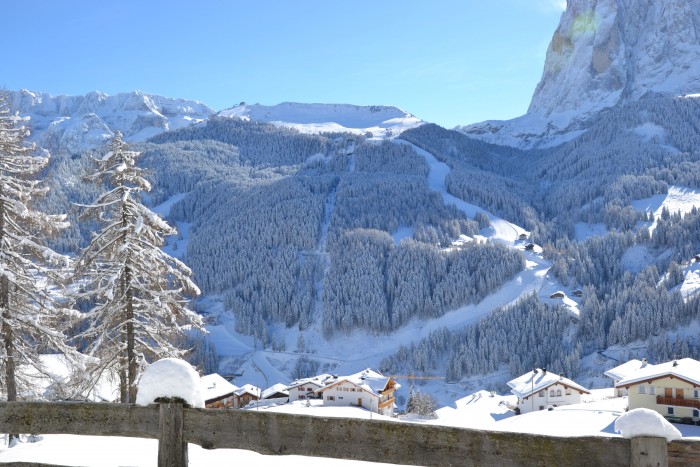
Runs to Santa Christina, the Saslong
Now I’ll turn to the runs down to Santa Christina fromn where you can continue into the Seceda area. The upper bowl directly beneath Ciampinoi summit is initially steep, followed by a wide carving slope to two chair lifts which depart a number of metres from one another. The runs here are FAST. Indeed the start of the Saslong generates enough speed for racers to carry them across the following “flat” at up to 120kmh!
Standing infront of the Ciampinoi lift house there is a slope descending right, a steeper one which descends directly and another which starts over by the top of a 2 man chairlift. They all lead the same way with the exception of the right hand version which splits to go to Selva di Gardena. The left most route is a short, unmarked black run and is steep but short, perfect for practicing your short turns. The central line is the start of the Saslong race course, an extremely steep pitch which is taken directly by racers. Discretion is advisable! The right hand line is frequently very busy before it splits and can get bumpy but is the only option if you want a red run.
Once down these initial slopes, they re-join to glide across the flat to the two lifts at a pinch point. The left hand lift leads up to two outlying red runs, the righthand one, back to Ciampinoi summit.
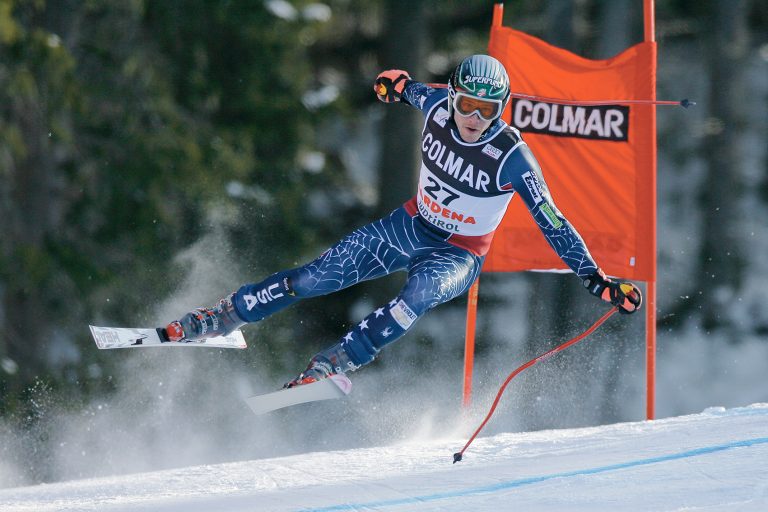
Now the fun really starts. From just below these lifts, Saslong splits into a red and a black – continue directly for Saslong A, a fast, rolling black which narrows and steepens just before dropping into Sata Christina, or take the much less difficult Saslong B red to the right which twists and winds its way down through the trees. Both are really excellent and if there is any criticism, it would be that they are a victim of their own success, frequently crowded and in the case of the black, it attracts holiday makers who want the feather in their cap of having skied an FIS race course, some of whom are ill prepared for the last narrow section. with a maximum gradient of 56.7%, it’s not for the faint of heart!
If you choose the red, as you reach the bottom of the mountain, look out for the renaissance castle on your right as you come into the stadium area – it’s very picturesque!
To reach Seceda, leave the stadium area and head right where you will find an underground tramway which whisks you beneath Santa Christina up to the northern slopes of Val Gardena.
Runs to Selva di Gardena
Returning to the summit of Ciampnoi lets now talk about how to get to Selva di Gardena. There are two options, a red and a black. Both start by taking the right hand most piste beneath the cable car. The black, Tre, continues directly whilst Ciampinoi 4 skirts the base of the lift house.
Tre is a beautiful run, which in many ways I prefer to the Saslong. It’s steeper and more technical and less busy. Seldom does it relent and it’s a great test for more advanced skiers who love short turns. This is reflected by the fact it’s used as a course for womens slalom races.
Ciampinoi is very similar in nature to Tre, just less steep and with breaks in the slope. Hug the lift house, then descend a ridgeline before dropping to your left at a junction into the trees.
Both these lifts lead down to a base area with a couple of ski tows at the back of Selva Gardena. Look carefully and you will find a small skiable passageway to the centre of the town where there are cafe’s and the key to Dantercepies and Passo Gardena.
Linking Plan de Gralba directly to Selva Gardena
The final run worth mentioning is somewhat of an outlier, and links Plan de Gralba directly to Selva. Called Funtanes, it is graded red but I really don’t know why as in my opinion its an amenable blue. It’s of no great note other than it’s value to link the two areas quickly and might be useful if you need to get to Passo Gardena in a hurry.
Dantercepies and Passo Gardena
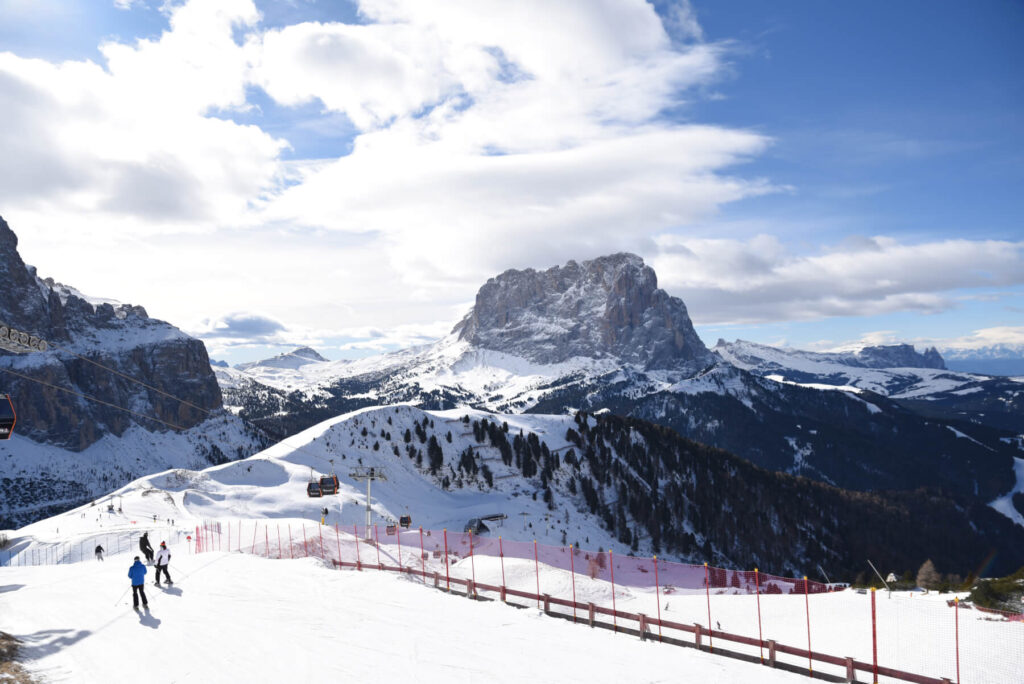
Dantercepies is quite a small area but what it offers is excellent. It’s easily accessed from the centre of Selva di Gardena by climbing up some stairs to a bridge over the main road through the valley. This takes one to a short lift followed by a ride on the main Dantercepies lift. This uplifts you to Passo Gardena with a midstation in the upper bowl a few hundred metres below the top. From the top you can cross over into Alta Badia to reach Corvara. You are greeted by amazing views of Sassolungo and the Sella massif.
The runs down are long, dropping directly from the pass at a shade under 2300m to Selva at 1575m. The base area consists mainly of a large skischool area with lots of ski tows and easy blues.
From the top there are two main options:
Cir, a black is an excellent black run used for womens downhill races. From the lift station take the rightmost line, it’s rolling and fast with some great steep drops around halfway down with sufficient twists and turns to allow fast descent and carved turns in amongst the woods. Lower down you have the option to either continue down to the Dantercepies lift, or turn right for the short but sweet black, Vallelunga.
Alternatively ski leftwards out of the lifthouse and after an initially steeper slope, the red Dantercepies levels out substantially into a wide easy run with a couple of variations part of the way down.
A last alternative is to follow the ridgeline down from the lift house to Panorama, a steep red and ski tow which accesses Wall a black which is often unpisted.
To return to Ciampinoi, return all the way to the base area, skiing through a tunnel to the right of the Dantercepies bubble lift. Continue to your left maintaining your speed and you will find a small skiable passageway between houses to reach the main road. Take your skis off and walk a few yards down the road to the Ciampinoi lift.
Seceda
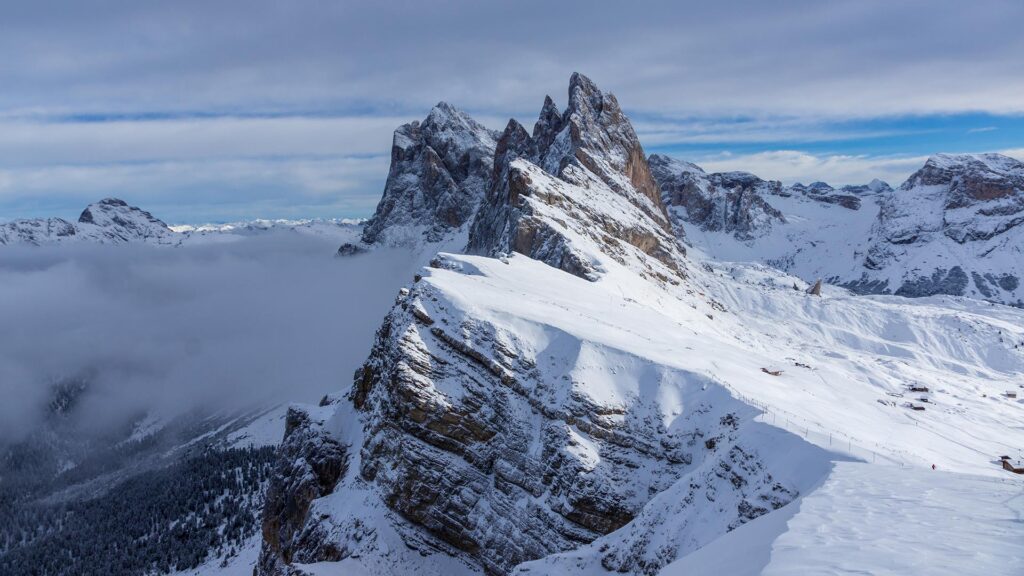
The final area in Val Gardena is an extensive group of pistes which link Santa Christina with Ortisei, the third major town in Val Gardena. These slopes are in the sun, and boast fantastic views. It can be accessed from either end; from Santa Christina there is a subterranean tram which departs from the stadium area of the Saslong, whilst from Ortisei there are a series of long travelators which depart from the central square of the town. Just find Sport Schmalzl (an excellent sport shop if you need to buy equipment) and walk down the alleyway to the right side of the shop.
Coming from Santa Christina, you reach the top by first a bubble lift and then a chairlift. From the first lift you can return to the base station by an pedestrian blue, a red or a steep but short black. Otherwise continue to the summit of Seceda where there is a wide and open bowl with a selection of Reds, and a blue and a black. All are quite amenable and the pleasure here really is the surroundings. It feels like a far more relaxed place to ski compared to the dark forests to be found on the opposite side of the valley. You can also take the long fun valley run down to Ortisei which seems to go on for ever, and here you will be able to join a Gondola back to the summit or continue across Ortisei to reach Alpe di Siusi.
One last thing to mention in this area, there is an outlying run from Rasciesa. This starts with a tram ride from not far from the Seceda gondola. It’s great as the piste down is empty and there is also the opportunity to rent toboggans for the day and to make the a 6KM sledge run back to the bottom, all aided by the excellent hut at the top of the mountain.